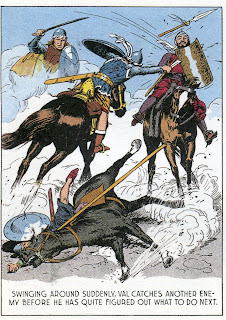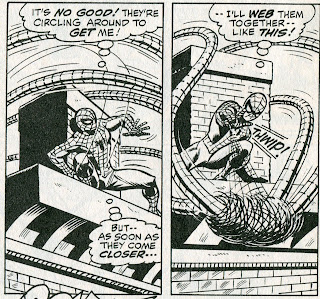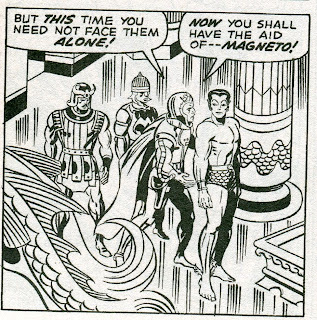It’s interesting to note the difference between Marvel's
Western heroes and those who lived in the DC Universe.
Marvel's gunslingers (who, for simplicity's sake, I will refer to as Marvels) were basically superheroes. They didn't have superpowers, but were pretty much all fast draws and nearly unbeatable in a hand-to-hand brawl. Most had code names: Rawhide Kid, Kid Colt, Phantom Rider. Several of them--such as Two Gun Kid--had secret identities.
Also, the Marvels would--through the occasional time travel story--openly interact with present day Marvel superheroes. Both the original and the West Coast Avengers spent time in the Old West, working alongside the Western heroes to foil villains such as Kang the Conqueror.
Even when on their own, the Marvels would sometimes go up against the odd superpowered threat. Rawhide Kid, for instance, once fought an alien invader that looked like a walking totem pole.
Over in DC, the Western heroes they had during the '40s and '50s had largely faded away after the resurgence of superhero comics. But in the 1970s, DC began introducing new characters into their version of the Old West. Scarred bounty hunter Jonah Hex was the best of these, but others (El Diablo, Bat Lash, Scalphunter) were also worth reading about.
DC's Old West was more "realistic" than Marvel, influenced more by Sergio Leone than by superheroes. (In fact, if Jonah Hex had been made into a movie in the 1970s, Clint Eastwood would literally been the only possible actor who could have played him.) They were gritty and violent--with these traits balanced out by three-dimensional characterizations and solid writing.
Neither approach to the Old West--DC or Marvel--is better than the other. Both produced many entertaining stories. But today we'll look a little more closely at one of DC's efforts.
Weird Western Tales 52 & 53 (from 1979) featured Scalphunter. Scalphunter's real name was Brian Savage, a white man raised by the Kiowas and now an outcast from both societies. Written by Gerry Conway and drawn by Dick Ayers, it was typical of the sort of intelligent storytelling being done by DC within the Western genre at the time.
One of the interesting features of the Scalphunter stories was that they were set during the Civil War (rather than after, as most Westerns are). In these issues, Scalphunter is approached by smooth-talking gambler Bat Lash, who tells him they've both been invited toWashington
by a beautiful Northern spy.
Once in the capital, though, they find they've become involved in a plot to kill President Lincoln. This sets the stage for a fast-moving conspiracy story in which the following happens: Bat Lash apparently double-crosses Scalphunter; a fun fight scene takes place atop (and then within) a half-finished Washington Monument; a last minute rescue or two is pulled off; and our protagonist and our 16th president engage in an arm-wrestling contest. And it's all done with a firm grasp of history--the leader of the conspiracy to killLincoln , for instance, is initially a
surprise, but it actually does make historical sense when the motivations are
explained. The skillful writing is complemented nicely by Dick Ayers' art, with
the action sequences all choreographed effectively.
We never really seem to tire of stories set in the Old West--it seems to be the perfect setting for believably combining the realistic with the mythological. Today, DC has once again given Jonah Hex his own book, while the Marvel gunslingers still pop up from time to time. In one way or another, the cowboy always seems to remain with us.
Marvel's gunslingers (who, for simplicity's sake, I will refer to as Marvels) were basically superheroes. They didn't have superpowers, but were pretty much all fast draws and nearly unbeatable in a hand-to-hand brawl. Most had code names: Rawhide Kid, Kid Colt, Phantom Rider. Several of them--such as Two Gun Kid--had secret identities.
Also, the Marvels would--through the occasional time travel story--openly interact with present day Marvel superheroes. Both the original and the West Coast Avengers spent time in the Old West, working alongside the Western heroes to foil villains such as Kang the Conqueror.
Even when on their own, the Marvels would sometimes go up against the odd superpowered threat. Rawhide Kid, for instance, once fought an alien invader that looked like a walking totem pole.
Over in DC, the Western heroes they had during the '40s and '50s had largely faded away after the resurgence of superhero comics. But in the 1970s, DC began introducing new characters into their version of the Old West. Scarred bounty hunter Jonah Hex was the best of these, but others (El Diablo, Bat Lash, Scalphunter) were also worth reading about.
DC's Old West was more "realistic" than Marvel, influenced more by Sergio Leone than by superheroes. (In fact, if Jonah Hex had been made into a movie in the 1970s, Clint Eastwood would literally been the only possible actor who could have played him.) They were gritty and violent--with these traits balanced out by three-dimensional characterizations and solid writing.
Neither approach to the Old West--DC or Marvel--is better than the other. Both produced many entertaining stories. But today we'll look a little more closely at one of DC's efforts.
Weird Western Tales 52 & 53 (from 1979) featured Scalphunter. Scalphunter's real name was Brian Savage, a white man raised by the Kiowas and now an outcast from both societies. Written by Gerry Conway and drawn by Dick Ayers, it was typical of the sort of intelligent storytelling being done by DC within the Western genre at the time.
One of the interesting features of the Scalphunter stories was that they were set during the Civil War (rather than after, as most Westerns are). In these issues, Scalphunter is approached by smooth-talking gambler Bat Lash, who tells him they've both been invited to
Once in the capital, though, they find they've become involved in a plot to kill President Lincoln. This sets the stage for a fast-moving conspiracy story in which the following happens: Bat Lash apparently double-crosses Scalphunter; a fun fight scene takes place atop (and then within) a half-finished Washington Monument; a last minute rescue or two is pulled off; and our protagonist and our 16th president engage in an arm-wrestling contest. And it's all done with a firm grasp of history--the leader of the conspiracy to kill
We never really seem to tire of stories set in the Old West--it seems to be the perfect setting for believably combining the realistic with the mythological. Today, DC has once again given Jonah Hex his own book, while the Marvel gunslingers still pop up from time to time. In one way or another, the cowboy always seems to remain with us.


















































